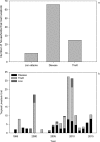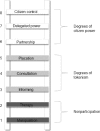Beyond the numbers: Human attitudes and conflict with lions (Panthera leo) in and around Gambella National Park, Ethiopia
- PMID: 30252886
- PMCID: PMC6155518
- DOI: 10.1371/journal.pone.0204320
Beyond the numbers: Human attitudes and conflict with lions (Panthera leo) in and around Gambella National Park, Ethiopia
Abstract
Human-lion conflict is one of the leading threats to lion populations and while livestock loss is a source of conflict, the degree to which livestock depredation is tolerated by people varies between regions and across cultures. Knowledge of local attitudes towards lions and identification of drivers of human-lion conflict can help formulate mitigation measures aimed at promoting coexistence of humans with lions. We assessed locals' attitudes towards lions in and around Gambella National Park and compared the findings with published data from Kafa Biosphere Reserve, both in western Ethiopia. We used household interviews to quantify livestock loss. We found that depredation was relatively low and that disease and theft were the top factors of livestock loss. Remarkably, however, tolerance of lions was lower around Gambella National Park than in Kafa Biosphere Reserve. Multivariate analysis revealed that education level, number of livestock per household, livestock loss due to depredation, and livestock loss due to theft were strong predictors of locals' attitude towards lion population growth and conservation. We show that the amount of livestock depredation alone is not sufficient to understand human-lion conflicts and we highlight the importance of accounting for cultural differences in lion conservation. The low cultural value of lions in the Gambella region corroborate the findings of our study. In combination with growing human population and land-use change pressures, low cultural value poses serious challenges to long-term lion conservation in the Gambella region. We recommend using Arnstein's ladder of participation in conservation education programs to move towards proactive involvement of locals in conservation.
Conflict of interest statement
The authors have declared that no competing interests exist.
Figures





Similar articles
-
Humans-livestock predators conflict in the Central and Eastern Part of Bale Mountains National Park, Ethiopia.BMC Ecol Evol. 2022 Oct 4;22(1):113. doi: 10.1186/s12862-022-02065-y. BMC Ecol Evol. 2022. PMID: 36195848 Free PMC article.
-
Effectiveness of a LED flashlight technique in reducing livestock depredation by lions (Panthera leo) around Nairobi National Park, Kenya.PLoS One. 2018 Jan 31;13(1):e0190898. doi: 10.1371/journal.pone.0190898. eCollection 2018. PLoS One. 2018. PMID: 29385146 Free PMC article.
-
Retaliatory killing negatively affects African lion (Panthera leo) male coalitions in the Tarangire-Manyara Ecosystem, Tanzania.PLoS One. 2022 Aug 31;17(8):e0272272. doi: 10.1371/journal.pone.0272272. eCollection 2022. PLoS One. 2022. PMID: 36044410 Free PMC article.
-
Mycobacterium bovis infection in the lion (Panthera leo): Current knowledge, conundrums and research challenges.Vet Microbiol. 2015 Jun 12;177(3-4):252-60. doi: 10.1016/j.vetmic.2015.03.028. Epub 2015 Apr 8. Vet Microbiol. 2015. PMID: 25891424 Review.
-
Managing conflict between large carnivores and livestock.Conserv Biol. 2018 Feb;32(1):26-34. doi: 10.1111/cobi.12959. Epub 2017 Jul 5. Conserv Biol. 2018. PMID: 28556528 Review.
Cited by
-
First direct evidence of lion hunting and the early use of a lion pelt by Neanderthals.Sci Rep. 2023 Oct 12;13(1):16405. doi: 10.1038/s41598-023-42764-0. Sci Rep. 2023. PMID: 37828055 Free PMC article.
-
Animals evoking fear in the Cradle of Humankind: snakes, scorpions, and large carnivores.Naturwissenschaften. 2023 Jul 5;110(4):33. doi: 10.1007/s00114-023-01859-4. Naturwissenschaften. 2023. PMID: 37405495 Free PMC article.
-
Human-Terrestrial Wildlife Conflict in Ethiopia: A Systematic Review.ScientificWorldJournal. 2022 Aug 29;2022:2612716. doi: 10.1155/2022/2612716. eCollection 2022. ScientificWorldJournal. 2022. PMID: 36072352 Free PMC article. Review.
References
-
- Bauer H, Packer C, Funston PF, Henschel P, Nowell K. Panthera leo: The IUCN Red List of Threatened Species; 2016. [cited 2017 August 14]. Available from: www.iucnredlist.org.
-
- Patterson BD, Kasiki SM, Selempo E, Kays RW. Livestock predation by lions (Panthera leo) and other carnivores on ranches neighboring Tsavo National ParkS, Kenya. Biological Conservation. 2004;119(4):507–16. 10.1016/j.biocon.2004.01.013. - DOI
-
- Kissui BM. Livestock predation by lions, leopards, spotted hyenas, and their vulnerability to retaliatory killing in the Maasai steppe, Tanzania. Animal Conservation. 2008;11(5):422–32. 10.1111/j.1469-1795.2008.00199.x - DOI
-
- Predators Woodroffe R. and people: using human densities to interpret declines of large carnivores. Animal Conservation. 2000;3(2):165–73. 10.1111/j.1469-1795.2000.tb00241.x - DOI
-
- Woodroffe R, Frank LG. Lethal control of African lions (Panthera leo): Local and regional population impacts. Animal Conservation. 2005;8:91–8.
Publication types
MeSH terms
Grants and funding
LinkOut - more resources
Full Text Sources
Other Literature Sources


